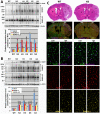Elevated global SUMOylation in Ubc9 transgenic mice protects their brains against focal cerebral ischemic damage
- PMID: 22016779
- PMCID: PMC3189225
- DOI: 10.1371/journal.pone.0025852
Elevated global SUMOylation in Ubc9 transgenic mice protects their brains against focal cerebral ischemic damage
Abstract
We have previously shown that a massive increase in global SUMOylation occurs during torpor in ground squirrels, and that overexpression of Ubc9 and/or SUMO-1 in cell lines and cortical neurons protects against oxygen and glucose deprivation. To examine whether increased global SUMOylation protects against ischemic brain damage, we have generated transgenic mice in which Ubc9 is expressed strongly in all tissues under the chicken β-actin promoter. Ubc9 expression levels in 10 founder lines ranged from 2 to 30 times the endogenous level, and lines that expressed Ubc9 at modestly increased levels showed robust resistance to brain ischemia compared to wild type mice. The infarction size was inversely correlated with the Ubc9 expression levels for up to five times the endogenous level. Although further increases showed no additional benefit, the Ubc9 expression level was highly correlated with global SUMO-1 conjugation levels (and SUMO-2,3 levels to a lesser extent) up to a five-fold Ubc9 increase. Most importantly, there were striking reciprocal relationships between SUMO-1 (and SUMO-2,3) conjugation levels and cerebral infarction volumes among all tested animals, suggesting that the limit in cytoprotection by global SUMOylation remains undefined. These results support efforts to further augment global protein SUMOylation in brain ischemia.
Conflict of interest statement
Figures




References
-
- Mergenthaler P, Dirnagl U, Meisel A. Pathophysiology of stroke: lessons from animal models. Metab Brain Dis. 2004;19:151–167. - PubMed
-
- Dirnagl U, Iadecola C, Moskowitz MA. Pathobiology of ischaemic stroke: an integrated view. Trends Neurosci. 1999;22:391–397. - PubMed
-
- O'Collins VE, Macleod MR, Donnan GA, Horky LL, van der Worp BH, et al. 1,026 experimental treatments in acute stroke. Ann Neurol. 2006;59:467–477. - PubMed
-
- Hallenbeck JM, Frerichs KU. Stroke therapy. It may be time for an integrated approach. Arch Neurol. 1993;50:768–770. - PubMed
-
- Frerichs KU, Hallenbeck JM. Hibernation in ground squirrels induces state and species-specific tolerance to hypoxia and aglycemia: an in vitro study in hippocampal slices. J Cereb Blood Flow Metab. 1998;18:168–175. - PubMed
Publication types
MeSH terms
Substances
Grants and funding
LinkOut - more resources
Full Text Sources
Molecular Biology Databases
Miscellaneous

